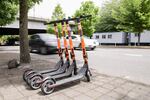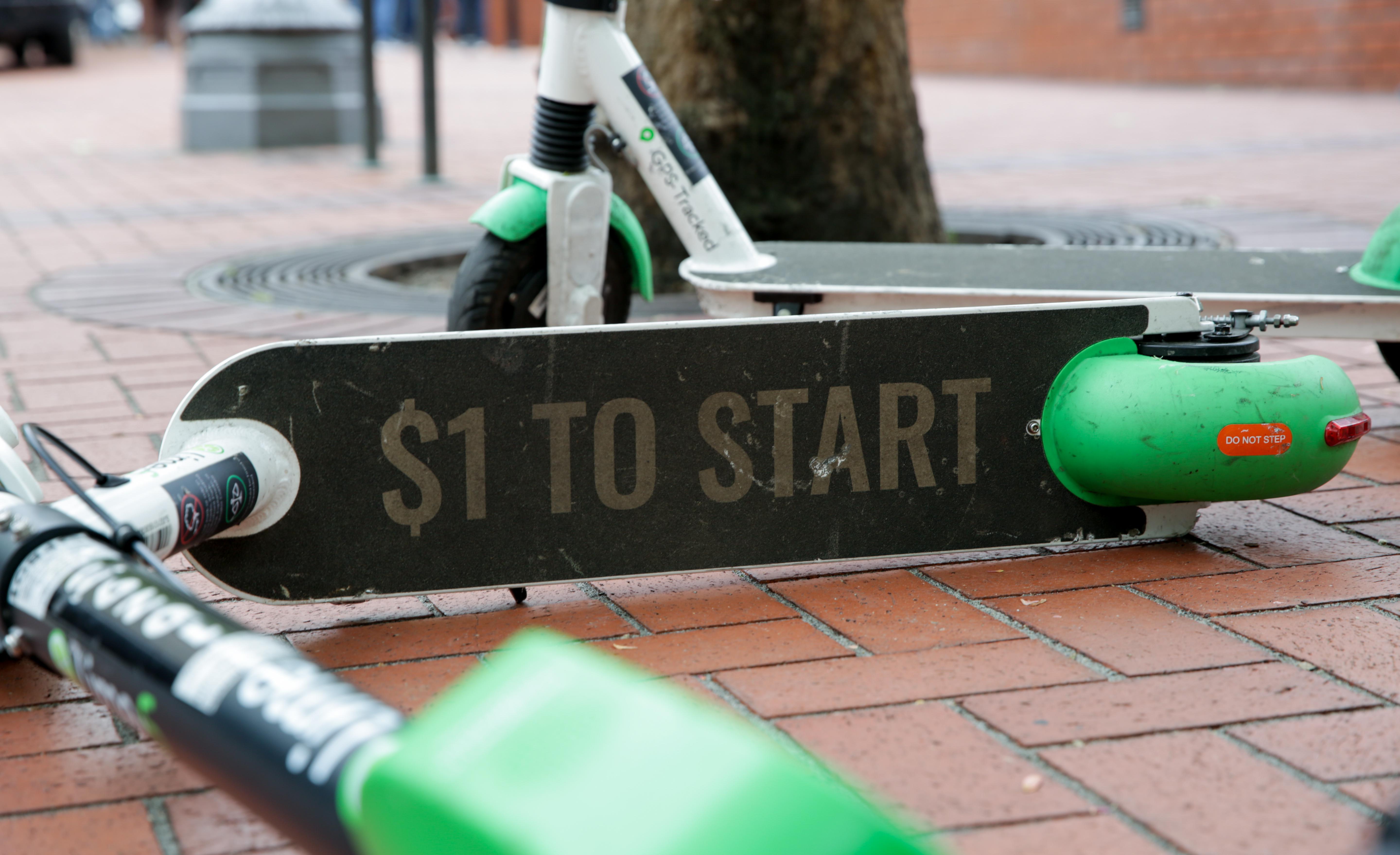Even on a gray, damp day, Cory Huff is still happy to rent an electric scooter.
Huff and his wife gave up on owning a car 12 years ago when they got tired of the upkeep and maintenance. Instead, he’s been focused on alternative forms of getting around such as Car2Go, public transportation and biking.
“I probably think about transportation more than most people because I don’t have a car,” Huff said. “I’m always thinking what is the most optimal way to get where I’m going because it’s not just about cost, it’s also about how fast will I get there, how safe will it be and how fun will it be.”
Huff is a digital marketing consultant and business owner. He works from home, but rides e-scooters about five or six times a week to run errands and go to meetings.
He was one of the people who accounted for some of the more than 700,000 rides that Portlanders took on electric scooters last year during the city’s four-month e-scooter pilot program.

Cory Huff prepares to ride a LIME electric scooter in downtown Portland, Ore., on Friday, May 17, 2019.
Bryan M. Vance / OPB
Now, e-scooters have returned for a full year, but not everyone in Portland is as excited as Huff.
Last year, the city’s pilot aimed to bridge gaps in transportation and get more people out of their vehicles, and for the most part, it did do that.
A report from the Portland Bureau of Transportation, or PBOT, the agency in charge of the e-scooter program, found that for many people last year, e-scooters were an introduction to active transportation.
The program also encouraged a good chunk of people to use e-scooters instead of cars. About 34% of Portlanders and 48% of visitors took an e-scooter instead of driving or using a ride-share program, the report states.
But still, there are a multitude of concerns around accessibility, safety and inclusivity when it comes to scooters in Portland.
“We’ve received quite a lot of complaints from people with disabilities within Portland mainly revolving around sidewalk access with e-scooters either by blocking part of the sidewalk, by being parked sideways or by being parked right on curb ramps,” said Matthew Denney, an attorney with the nonprofit legal group Disability Rights Oregon.
Although people can technically park e-scooters on the sidewalk, they must be near a bike rack or close to the curb, so as to not block access.
E-scooter users illegally riding on sidewalks was also an issue last year.
Dylan Rivera is with PBOT. He said they’ve been keeping those issues in mind when talking with Disability Rights Oregon about this new pilot program.
Specifically, while the old program focused solely on education, the new one allows for penalties to be issued against riders.
“We’ll have PBOT regulatory specialists monitoring sidewalks especially for illegal scooter riding and parking and providing that information to the companies,” Rivera said.
From there, the companies — not PBOT — will issue warnings, fines and suspensions.
Disability Rights Oregon is concerned about that.
Rivera said PBOT will analyze the data, including the number of rides taken, injuries and complaints. Just like a report they put out last year, that data will be public, he said.
Still, with three different, private scooter companies being held accountable for the data, Denney said he worries that negative information, like complaints, could easily be withheld, and fines and warnings may not be issued.
“We’re concerned that this is a way for the companies to kind of self-police and that it’s going to result in actually less information coming out of this pilot than last pilot,” Denney said.

Commuters pass by a row of parked SPIN electric scooters on SW Naito Parkway in downtown Portland, Ore., on Friday, May 17, 2019.
Bryan M. Vance / OPB
Jeremy Nelson is Oregon’s general manager for Lime, one of the companies in both the current and former e-scooter pilot programs. Nelson said the company has incentive to take action against problematic riders.
“We don’t want these folks who repeatedly are causing problems to be on our scooters,” he said. “We actually welcome the opportunity to understand when someone is doing something wrong and we actually want to educate those riders.”
The new complaint process is another concern for Disability Rights Oregon.
Last year, people could send general complaints directly to PBOT. This led to the agency receiving more than 6,000 complaints about scooters and riders from Portlanders, most of them related to riders not wearing helmets or riding on sidewalks.
This year, the complaint process must go through each individual scooter company — and the complaint must identify a specific rider.
A major issue in this for Denney is that people must record a “permit number” from the front of the scooter in order to make a complaint.
“If you don’t know the number of the scooter because it went by you on the sidewalk or you didn’t get it when you walked by it, there’s not actually a way to send a complaint into the company,” he said. “I think that’s going to discourage a lot of people from even sending in complaints.”
Nelson with Lime said that number on the front of the scooters is the only way to hold individual riders accountable.
“Without that, there are hundreds of thousands of trips taken, and it would be like saying, ‘A red car was going too fast,’” he said. “But if you can say, ‘A red car with a certain license plate number,’ which essentially is what the permit number on the front of the scooter acts as, then we’re able to identify an individual.”
Nelson said that Lime has “suspended several riders whose behavior was extremely negative” so far, after receiving all of the information needed to identify the people, including the permit number.
Related: Data Show Women Ride Portland E-Scooters Less Than Men
Along with ongoing uncertainty from Portlanders with disabilities, there have also been concerns surrounding accessibility and inclusivity with the e-scooters.
The first pilot worked successfully on extending ridership outward from Portland’s core — to North Portland and East Portland — in a push to include people of color and low-income Portlanders.
Nelson with Lime said the company is trying to make scooters accessible by offering discounts for underserved communities with Lime Access — a program that gives a 50% discount to riders on local or federal assistance programs.
According to Portland State University researcher Jennifer Dill, data from last year's program shows that ridership with respect to race and income was relatively balanced. She found the biggest gap in ridership is with gender.
Dill found that only about a third of Portland e-scooter riders last year were women. The issue was safety, she said.
“Women want safer, more separated infrastructure,” Dill said. “A white-striped bike lane is not enough to make a lot of women feel safe biking on the street and the same thing goes for e-scooters.”
Rivera with PBOT said, even though there’s a need for more data collection, he agrees.
“Our strong suspicion is that as we grow our network of protected bike lanes, we’ll see more women riding bicycles and potentially more women riding e-scooters,” he said.
Rivera said that a portion of the money from all e-scooter rides will go toward improving bike infrastructure.
Although there are only about 1,000 e-scooters on Portland streets currently, by early 2020, Rivera says there will probably be 8,000 or 9,000.

